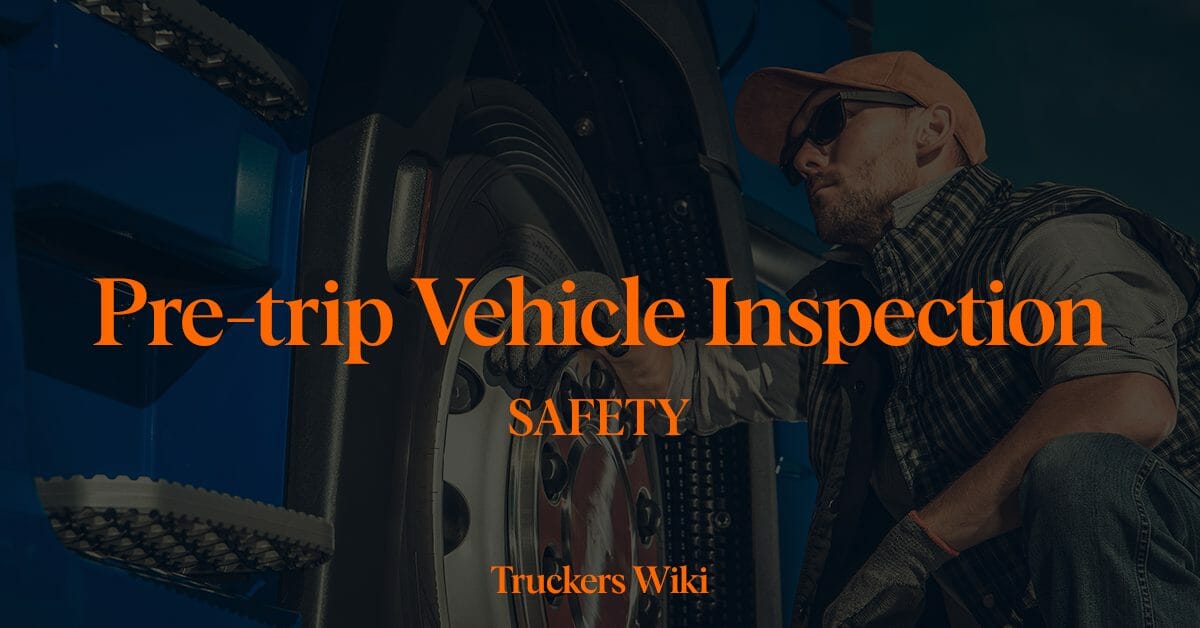
Table of Contents
What is a Pre-trip Vehicle Inspection
Pre-trip vehicle inspection is a mandatory check performed by the driver before starting a journey, ensuring that the truck and any attached trailer are safe and operational. This inspection includes checking tires, brakes, lights, steering, fluid levels, and securing of the cargo, among other critical components, to prevent accidents and breakdowns on the road.
Purpose
The primary objective of a pre-trip vehicle inspection is to identify and fix any potential issues before they can cause accidents, breakdowns, or other hazards. This process helps ensure the safety of the driver, the vehicle, the load, and other road users.
Components to be inspected
A thorough pre-trip inspection covers various components of the vehicle, including, but not limited to:
General overview: Checking the overall condition of the vehicle and its surroundings.
Engine compartment: Inspecting fluid levels, belts, hoses, windshield wipers and the battery.
Cab area: Verifying proper functioning of controls, gauges, and instruments, as well as checking mirrors, wipers, and the windshield for cracks or damage.
Lights and reflectors: Confirming that all lights, including headlights, brake lights, turn signals, and clearance lights, are clean, functional, and free of damage.
Tires, wheels, and rims: Examining tire inflation, tread depth, and checking for damage or debris lodged between dual tires. Inspect wheels and rims for cracks, loose lug nuts, or other issues.
Learn about Tire Maintenance here.
Suspension and steering systems: Looking for loose or damaged parts, leaks, or excessive wear.
Learn about Suspension and Steering Maintenance here.
Brake system: Checking for leaks, air brakes, parking brakes, air pressure, power steering and inspecting brake components, including drums, linings, hoses, and slack adjusters making sure it is all working properly.
Learn about Brake System Maintenance here.
Fuel system: Ensuring proper fuel level, checking for leaks or damaged fuel tanks.
Exhaust system: Inspecting for leaks, excessive noise, and damage.
Coupling devices: Verifying that the fifth wheel or pintle hook is properly connected and secured.
Cargo securement: Confirming that the load is properly distributed and secured, checking for potential hazards such as loose straps or shifted cargo.
Performing the inspection
Truck drivers must be familiar with their vehicles and perform a thorough, systematic inspection following a consistent sequence. Many drivers opt to follow a clockwise pattern around the vehicle, starting with the front left corner and moving around the vehicle to ensure that no components are overlooked.
Documentation
The driver must maintain a record of each pre-trip inspection, either on paper or electronically. The record should include the date, vehicle identification, defects or deficiencies discovered, and any corrective action taken. If no issues are found, the driver must still complete the report, indicating that the inspection was performed with no defects found. These records must be retained for three months.
Driver qualification
Truck drivers are required to demonstrate their ability to perform a proper pre-trip inspection as part of obtaining a Commercial Driver’s License (CDL). This includes a written test and a hands-on skills test.
Penalties for non-compliance
Failing to perform a pre-trip inspection or neglecting to address identified issues can result in fines, penalties, or out-of-service orders from the Department of Transportation (DOT) and FMCSA. In addition, it can lead to increased vehicle downtime, costly repairs, and potential accidents.
Learn more about DOT here.
In summary, a pre-trip vehicle inspection is an essential practice for truck drivers in the USA. It helps ensure the safety and reliability of commercial vehicles on the road, preventing accidents and costly downtime. Proper documentation, driver training, and adherence to inspection procedures are crucial in maintaining compliance with FMCSA regulations and ensuring the well-being of all road users.
In case you are studying for your CDL here is a YouTube video of Apex CDL Institue that demonstrates the Pre-trip Vehicle Inspection.
Few Additional Tips for Pre-trip Inspection Process
Be proactive: In addition to the mandated pre-trip inspection, it’s essential for drivers to maintain a proactive mindset when it comes to vehicle maintenance. Regularly checking for wear and tear, and addressing minor issues before they become significant problems, can save time and money in the long run.
Familiarize yourself with the vehicle’s quirks: Every truck is unique, and knowing the specific features or tendencies of your vehicle can help you identify potential issues more quickly. Familiarity with your truck allows you to detect abnormalities, such as unusual noises or vibrations, that could indicate a problem.
Stay organized: Developing a consistent routine for your pre-trip inspections can help you stay organized and ensure that you cover all necessary components. Some drivers prefer using a checklist or a mobile app to guide them through the inspection process.
Post-trip inspections: In addition to pre-trip inspections, it’s a good idea to perform a post-trip inspection after each workday. This helps identify any new issues that may have arisen during the trip and allows you to address them before they escalate.
Keep up with industry updates: Stay informed about updates to FMCSA regulations and inspection requirements, as well as any changes in industry best practices. Participate in ongoing training, attend industry conferences or workshops, and network with other drivers to stay current.
Engage with your company’s maintenance team: Communicate with your company’s maintenance team regularly to address vehicle concerns or issues. A strong working relationship between drivers and the maintenance team can lead to more efficient problem resolution and improved vehicle performance.
By following these tips and adhering to the mandatory pre-trip inspection requirements, truck drivers can help ensure the safety and reliability of their vehicles, contributing to a safer road environment for everyone.
Pre trip inspection is a process designed to ensure the safety and efficiency of commercial motor vehicles (CMVs) before they hit the road. Pre-trip inspections are mandated by the Federal Motor Carrier Safety Administration (FMCSA), which enforces the regulations set forth in the Code of Federal Regulations (CFR), Title 49, Part 396, Section 11.
FAQ - Summary
Yes, a pre-trip inspection is required by the U.S. Department of Transportation (DOT). Specifically, it’s enforced by the Federal Motor Carrier Safety Administration (FMCSA), a division of the DOT.


